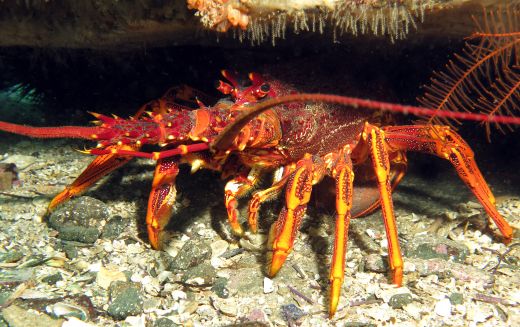
A new Institute for Marine and Antarctic Studies (IMAS)-led study has found that everyday marine noise from human activity can harm lobsters in the same way as high -intensity signals from seismic air guns used in mineral exploration.
The impact of seismic exploration on scallops, zooplankton and lobsters has previously been identified by IMAS research teams, but little is known about the effects of other human activity such as shipping.
compared spiny lobsters from a high-traffic shipping lane in Hobart close to a pumping station with lobsters from a quiet, remote area.
Lead author Dr Ryan Day said the lobsters from the high-noise area suffered similar damage to lobsters exposed to seismic air gun signals, suggesting that a range of other human-induced sounds may be just as harmful.
“There is growing awareness of the impact that seismic air gun signals can have on a number of marine species,” Dr Day said.
“But we didn’t expect to find that other sounds from shipping and a nearby water pumping station could inflict similar levels of damage on spiny lobsters.
“The lobsters from a noisy area that we studied suffered damage to their statocyst, an organ comparable to the human ear, which helps to control their position in the water, movement and righting reflex.
“The impact was comparable to that in lobsters exposed to air guns but, interestingly, their behaviour and righting reflex did not seem impaired, suggesting they had adapted to cope with their noisy environment.
“Unlike the sharp, high-intensity signals generated by seismic air guns, shipping and other industrial noises tend to be continuous and lower frequency, potentially resulting in chronic exposure for marine organisms across the ocean,” Dr Day said.
Dr Day said the noisy study site had a 5-10 decibel greater level of noise than the remote site, equivalent to 3-10 times higher intensity.
Co-author and study leader Professor Jayson Semmens said the potential harm that aquatic noise can cause to marine invertebrates is only now being understood.
“Quantifying the impact on a valuable commercial species such as lobsters is a crucial first step towards being able to maintain fisheries, particularly along busy coastlines where noise pollution is most likely,” Professor Semmens said.
“Our study did not pinpoint which particular noise sources were responsible for the damage, and further research is needed to allow us to understand better the causes and mechanisms involved,” he said.
The research was funded by the Australian Government through the and included researchers from Curtin University.







